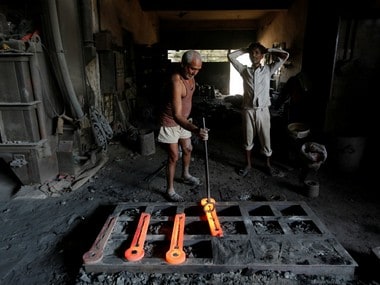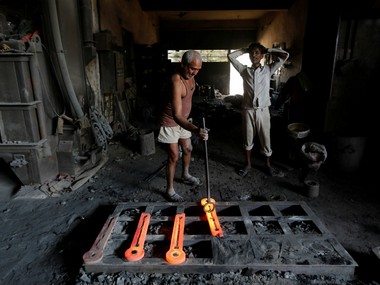Just around an hour after the Central Statistics Office (CSO) put out growth numbers for the first quarter (Q1) of 2019-20, the chairman of the Prime Minister’s Economic Advisory Council (PM-EAC) issued an appeal: Avoid hand-wringing and spreading negativity. This may be a valid appeal, but it is a difficult ask when, at 5 percent, this Q1 growth is the lowest in twenty-five quarters and growth since Q4 of 2017-18 (8.1 percent) has been dipping lower every quarter. [caption id=“attachment_4391191” align=“alignleft” width=“380”]  Representational image. Reuters.[/caption] Few sectors have remained unaffected, though it was manufacturing which posted the worst performance, with growth stagnant at 0.6 percent. Growth in both agriculture (2 percent) and construction (5.7 percent) was almost half of what it was in Q1 of the previous fiscal. These three sectors are crucial for employment. Look also at private consumption and investment. Private consumption growth, at 3.1 percent in Q1 of this fiscal was an 18-quarter low. Gross fixed capital formation (representing investment) grew only 4 percent. The shares of both in GDP also slipped. Private consumption was 57.7 percent of GDP in Q1 of this fiscal against 58.7 percent in Q1 of 2018-19. It is also a steady decline from 61.2 percent in Q3 of 2018-19 and 59.3 percent in Q4. The anecdotal evidence of falling consumption is now borne out by macro data. The investment rate slipped from 28.8 percent in Q1 of 2018-19 to 27.9 percent in Q1 of the current fiscal, which is also lower than the 30.2 percent logged in Q4 of the previous fiscal. The last capacity utilisation numbers from the Reserve Bank of India (RBI) are for Q4 of 2018-19 and these show an increase of just 0.2 percentage points (from 75.9 to 76.1). This, incidentally, was the lowest increase in 2018-19. The only recent figures on investment are from CMIE and these show that new projects in Q1 of the current fiscal was down to Rs 0.75 trillion from Rs 2.48 trillion in Q4 of 2018-19.
These numbers are bad. No amount of exhortation by the PMEAC or other agencies of the government is going to change that. And things are likely to get worse before they get better. There have been confirmed job losses in the automobile sector and this is likely to have a trickle-down effect on other sectors. This means consumption recovery is not going to happen soon.
And these bad numbers fall into the account of this government alone. In its first term, it did, indeed, inherit a mess from the United Progressive Alliance government and so got sympathy when it pointed fingers at Manmohan Singh and P Chidambaram. This time it has inherited a mess from itself. Sure, the global environment has changed and queered the pitch. But India could have been on a stronger wicket if the first Narendra Modi government had not missed several opportunities to strengthen the economy (this is not to take away from the few reforms it did undertake). What the PMEAC and NITI Aayog need to do is direct some exhortations to the government. A $5 trillion economy cannot be built on such a base; it needs careful nurturing. That nurturing was not given to the green shoots that did appear on the economic landscape after the poor showing of the UPA years; so they withered away. The PMEAC has said constructive criticism and suggestions are welcome. There are many out there and it should persuade the government to act on these. The RBI annual report said that though the slowdown was cyclical and not structural, a number of structural reforms are needed. The PMEAC and NITI Aayog need to keep prodding the government to undertake these. Fortunately, the big announcements by the government over the last two week—on taxes, foreign direct investment and the banking sector—show the government is no longer with its head in the sand where the economy is concerned. The government needs to continue on this path, with special focus on agriculture and construction. The land and labour markets need far-reaching reforms. Some of these may come up against legislative roadblocks (labour laws, for example) or federal silos (agriculture is a state subject). Modi will have to figure out creative ways of getting around this. The gains will not come overnight, but they will put the economy on a sound foundation. Undertaking these reforms may, perhaps, help the government get around the limited fiscal elbow room it currently has. But for all this, the government’s singular focus has to be the economy. Modi may not have the luxury of choosing between economic management and delivering on the core agenda items of the BJP’s core base. In which case, he and his government will have to fire on all fronts. There is just no getting away from that. (The writer is a senior journalist and author. She tweets at @soorpanakha)


)

)
)
)
)
)
)
)
)



